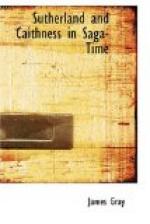[Footnote 12: See Du Chaillu, The Viking Age, vol. ii. pp. 65-101.]
[Footnote 13: Worsaae, The Prehistory of the North, pp. 184-7. Scandinavian Britain, pp. 34-42.]
[Footnote 14: Viking Society’s Orkney and Shetland Folk, 1914.]
[Footnote 15: Robertson, Early Kings, vol. i, p. 105, and ii, p. 469.]
[Footnote 16: Dun-bretan, or the fort of the Britons; Alcluyd, the rock of the Clyde.]
CHAPTER III.
[Footnote 1: H.B., vol. i, p. 22.]
[Footnote 2: Chron. Hunt. Skene, Chron. Picts and Scots, p. 209.]
[Footnote 3: See also Rhys, Celtic Britain, p. 198.]
[Footnote 4: Flatey Book, vol. i, ch. 218.]
[Footnote 5: H.B., vol. i, p. 27.]
[Footnote 6: Haroldswick in Unst is said to have been called after King Harald. Tudor, O. and S., p. 570.]
[Footnote 7: Ekkjals-bakki is clearly Oykel’s Bank, the high bank or [Greek: ochthe hypsele] of Ptolemy. “Ochill” is the same word. As for Bakke, see Coldbackie and Hysbackie near Tongue.]
[Footnote 8: O.S., ch. 4, 5.]
[Footnote 9: The late Dr. Joass had identified the site of the burial mound. It is said to be Croc Skardie on the S.E. bank of the River Evelix, near Sidera. Skardi is a Norse word, and probably means a gap, or a twin-topped hillock, which it is.]
[Footnote 10: H.B., i, p. 28.]
[Footnote 11: See Skene’s Chronicles of the Picts and Scots, pp. 8, 9 and lxxv, and Celtic Scotland, vol. i, 339, note.]
[Footnote 2: An able paper on this subject by the late Mr. R.L. Bremner was read to the Viking Society, and it is hoped may be printed. But Brunanburgh is usually located south of the Humber, or in the Wirral in Cheshire. See Scandinavian Britain, pp. 131-4 where it is located on the west coast, and on this coast it probably was.]
[Footnote 13: See Genealogie of the Earles, pp. 1 and 2, as to the “boundaries of Southerland.”]
[Footnote 14: F.B., vol. i, pp. 221-9. See Trans. of O.S., Hjaltalin and Goudie, App. pp. 203-212. See also St. Olaf’s Saga, c. cix. See also generally Vigfusson’s Prolegomena to Sturlunga Saga, Introduction, p. xcii, vol. i.]
[Footnote 15: The “scurvy Kalf” and “tree-bearded Thorir.”]
[Footnote 16: O.S., ch. 6, 7.]
[Footnote 17: O.S., ch. 8, on Rinar’s Hill. Tudor, O. and S., p. 364.]
[Footnote 18: O.S., ch. 80. But see Heimskringla, Saga Library, i, 96 and St. Olaf’s Saga, ch. cv and cvii.]
[Footnote 19: See Blackwood’s Magazine, April 1920; an able and interesting article intituled A Branch of the Family, by J. Storer Clouston.]




